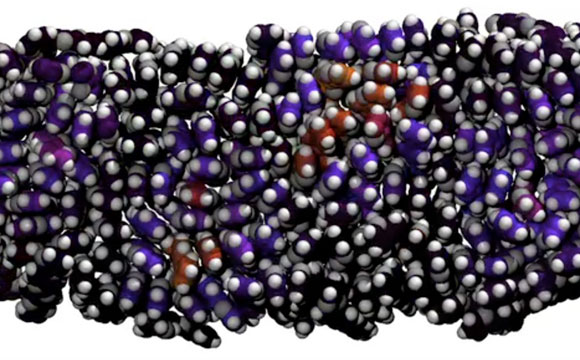Organic Photovoltaic Material Offers Great Promise for Solar Energy
 November 6: Scientists at MIT believe modeling electron excitation in organic photovoltaic material could change the future of solar energy.
November 6: Scientists at MIT believe modeling electron excitation in organic photovoltaic material could change the future of solar energy.
The semi-conducting plastic is lightweight, flexible, relatively inexpensive, and easy to make. The problem is that, unlike inorganic photovoltaic material, it is not very efficient or stable. But work by Adam Willard, an assistant professor in the Department of Chemistry at MIT, has the potential to change that.
Willard is a theoretical chemist who uses modeling and simulation to study molecular systems. The goal of his research group is to explore and understand the fundamentals and consequences of molecular disorder — which lies at the heart of the challenge posed by organic photovoltaic material.
While organic photovoltaic films may appear smooth and homogeneous to the naked eye, they are extremely disordered at the molecular scale, where they appear as a giant tangle of unaligned molecules. That tangle makes it difficult to understand how electrons, when excited by photons, could more easily travel through the structure and reach an external electrode. Even understanding the behavior of a single electron is a challenge.
“The position and shape of the excited electron are dynamic and affected by extremely subtle changes in nuclear motion,” Willard explains. “You can imagine the difficulty of understanding millions of subtle nuclear motions and their impact on millions of electrons.”
Until recently, researchers were unable to even consider this kind of problem.
“Computers have become so fast and efficient that we can explore a whole class of problems computationally that we couldn’t touch 50 years ago,” Willard says. “For years, the solution to many theoretical chemical problems had to be found analytically by pencil and paper, which meant that many approximations had to be made in order to make the solution analytically tractable. Now, the technology can do the legwork. We’re able to explore the molecular consequences of approximations that have been made and that have shown up in textbooks, and to address where some of these approximations break down or fail to predict behavior.”
Willard is using computers available to MIT faculty at the Massachusetts Green High Performance Center (MGHPCC). The MGHPCC provides world-class computational infrastructure, indispensable in the increasingly sensor and data-rich environments of modern science and engineering discovery.
Even with today’s high-performance computers, modeling the behavior of excited electrons on a single large molecule is close to the limit of what is currently feasible, and ensembles of hundreds of molecules are out of reach. To get around this limit, Willard is taking a multi-level approach, simulating the behavior of excited electrons in individual molecules, then applying what he has learned to models consisting of many simplified molecules. This transforms the problem from one that requires a single prohibitively large computation to one that requires many relatively simple computations. The latter can be distributed across platforms that contain many individual processors.
“Understanding how electrons make their way from deep inside photovoltaic material to where they can be collected, and used to power our fans and light bulbs, is a challenging problem, but one that needs to be addressed for this material to cross over into the realm where it can be useful at the global scale,” Willard says.
Source: Department of Chemistry, MIT
